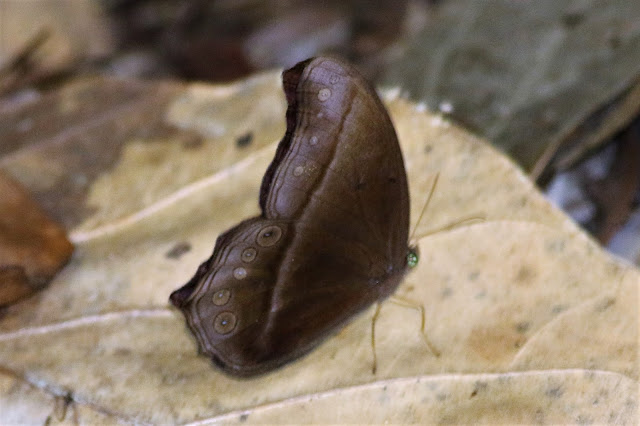The month of March saw a combination of rain in the afternoon and sunshine in the morning. In between those weather patterns, I managed to tick my two hundreds (200 +) confirmed and photographed new butterfly species.
Chocolate Albatross (Appias lyncida vasava)
The above rather plain looking Chocolate Albatross maybe from a wet morph. It's a common butterfly from this region.
A frontal look of the male Chocolate Albatross.
The above is the female Chocolate Albatross (Appias lyncida vasava). It was seen together with the above male.
A male Chocolate Albatross (Appias lyncida vasava) in flight
A pair of Chocolate Albatross together with five Common Grass Yellow (Eurema hecabe hecabe) puddling on a wet forest floor.
Here is my 200 new butterfly
The Malayan Count (Tanaecia godartii asoka)
The above is a male and its scientific name might be referring to an ancient Indian emperor named Ashoka from the Mauryan empire (about 268bc).
White-banded Flat (Celaenorrhinus asmara asmara)
The above "flat" was my 201 newly photographed butterfly. It's considered an uncommon to rare butterfly in this region. Saw three of them in one location, chasing each other away from their favourite perch. By late morning they were all gone in a wink of an eye. This "flat" was sunning itself and you can see the sun ray penetrating its left white discal band.
Here is a rarely seen upperside of a Chocolate Pansy (Junonia hedonia ida)
It was sunning itself on top of a tree. I have to climb up a branch in order to take this photo.
Painted Jezebel (Deliashyparete metarete)
Although described as common but I think they are more seasonal as you don't see them everyday.
It's not like everyday they will open up their wings for you.
Here is the side profile of a male Common Imperial (Cheritra freja frigga). Each of its long tail can function autonomously (i.e independent from each other)
Common Posy (Drupadia ravindra moorei)
I have been seeing Common Posy together with Branded Imperial, Malayan Tailed-Judy and Malayan Plum Judy since December 2020 but with lesser numbers.
I think this could be an "Isma umbrosa umbrosa" (Large Long-banded Flitter)
Large Long-banded Flitter ?
Banded Demon (Notocrypta paralysos varians)
Not many people like to post skippers' photos but some of them can be quite attractive too.
Like this one below
Brown Bob (Psolos fuligo)
Lesser Dart (Pothanthus omaha omaha)
It just landed here from the Omaha beach.
The above butterfly was just a Common Cerulean (Jamides celeno celeno)
I initially thought that the above butterfly could be a 'Jamides alecto ageladas' but it was differentiated by the experts from a 'Common Cerulean' by the more straighter forewing lines on a 'Common Cerulean' as depicted below.
Another common butterfly - "Common Hedge Blue" (Acytolepis puspa lambi)
Here's a sailor who likes to eat papaya.
A Common Sailer (Neptis hylas papaja)
Its upperwings will look more brownish when in contact with direct sunlight.







































































